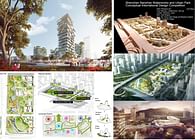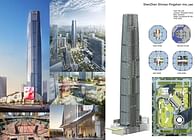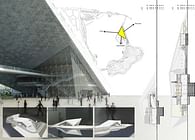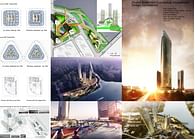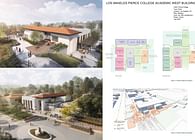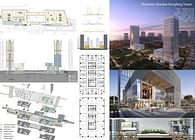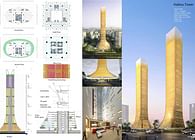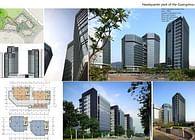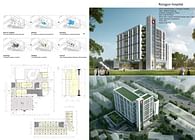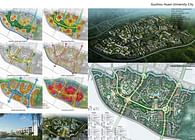
This is a conceptual design for a primary school campus. Playing a leading role in the designing process, I led 2 junior architects to complete the design within 3 weeks. The major philosophy of the design is to combine the traditional spirit of the region and green energy-saving technology to create a campus that not only reflects local culture but is also comfortable, energy efficient, and environmentally friendly. The aerial view on the lower left shows that the whole design is made up of 3 parts. The north part consists of a sports field linked to the city's arterial street. The middle part is the public area of the school, made up of the gymnasium surrounding the entrance square, the library, and public classrooms. In the south of the campus are separate classrooms. The whole layout manifests a transition from dynamic to static. Serving as a buffer between the teaching building demanding quietness and the city road, the sports field in the north can effectively reduce noise. The public area in the middle acts as a transition between the dynamic and static sections. The entrance square, which is formed by the closure of 3 sets of buildings, makes a good place for school assemblies. In the south of the campus are quietness-requiring separate classrooms. The mispositioned building strips form 5 different activity courts, each with a distinct theme so that students of the same grade will have their own area to play in. Students from different classes but in the same grade can play, communicate, and share their emotions here.
On the top left corner is a vertical view of the architecture. Generally, this is a lively and modern campus, but it has also blended in many traditional architectural terms, for example, the slightly undulating curved roof reminds students of the roof of traditional Chinese architecture. Made up of solar panels at different angles, the surfaces of the roof can also collect rainwater. Window decorations with local features are chosen for the staircases, the school gate, and the gymnasium. This type of building component can effectively reduce the trans-meridional dazzle light and acts as a sunshade. In my opinion, through elaborate design, we can perfectly combine beauty, culture, energy conservation, and comfort.
The analysis graph on the top left demonstrates the strategy of energy conservation and comfort. This is a strategy aiming to achieve maximized goal by adopting a feasible design on the premise of a limited budget. Having analyzed the climate and solar environment of the project site, we decided to adopt a layout pattern that combines the veranda style and courtyard style. From the profile map of the building, we can see that the classrooms lie in the north with the verandas in the south. There are windows on both walls of the classrooms and the verandas can block direct sunlight, preventing dazzling light from getting through. The lower right corner is the daylight autonomy I made for the basic unit. It shows that SDA can achieve a 100% effect. In addition, based on the modeling division of the facade, I arranged different plantations in different places. The trees and the courtyard make cross-ventilation possible and facilitate air filtration. Considering the humid and hot weather, we designed a corridor along the vertical axis of the campus so that students can get to every corner of the campus with comfort on rainy days.
Status: Built
Location: Guangzhou, CN
My Role: Design Director
Additional Credits: Guangdong Overseas Architecture Design Institute Co., Ltd.
